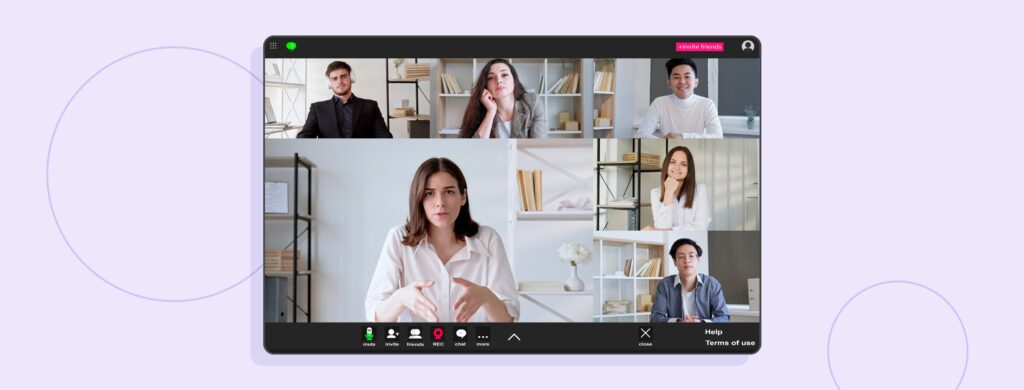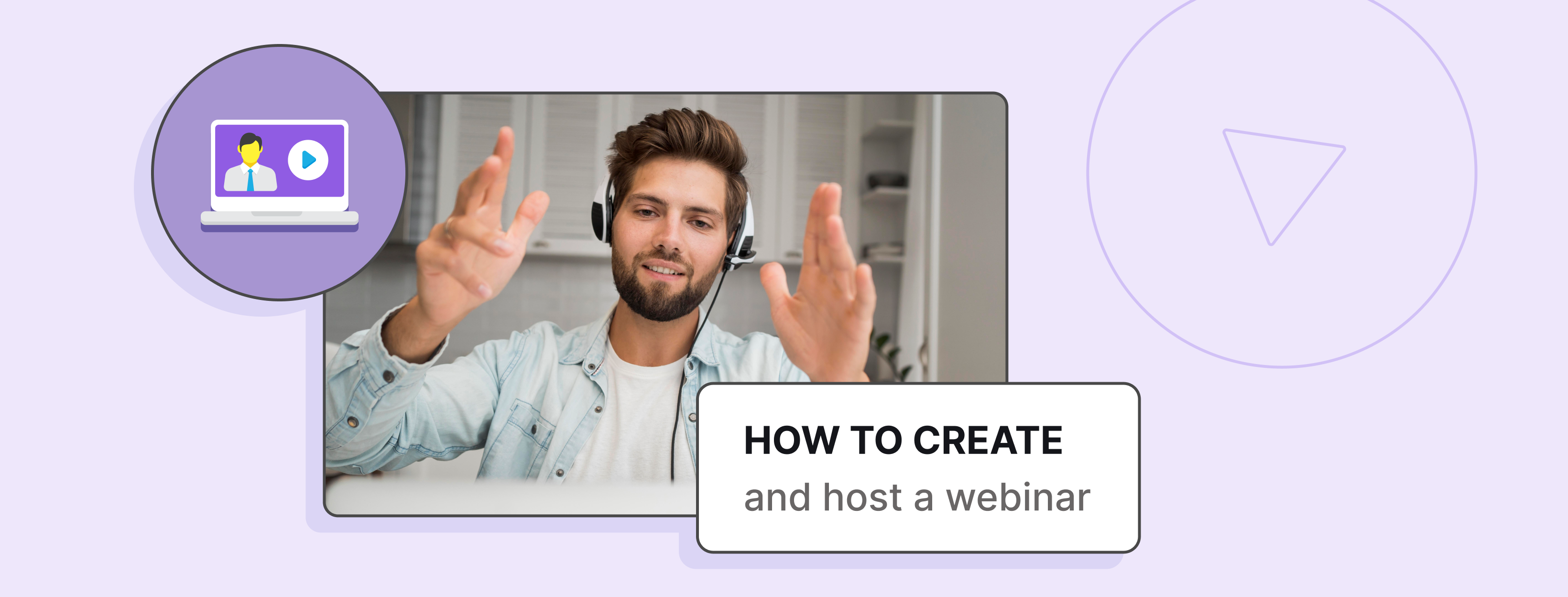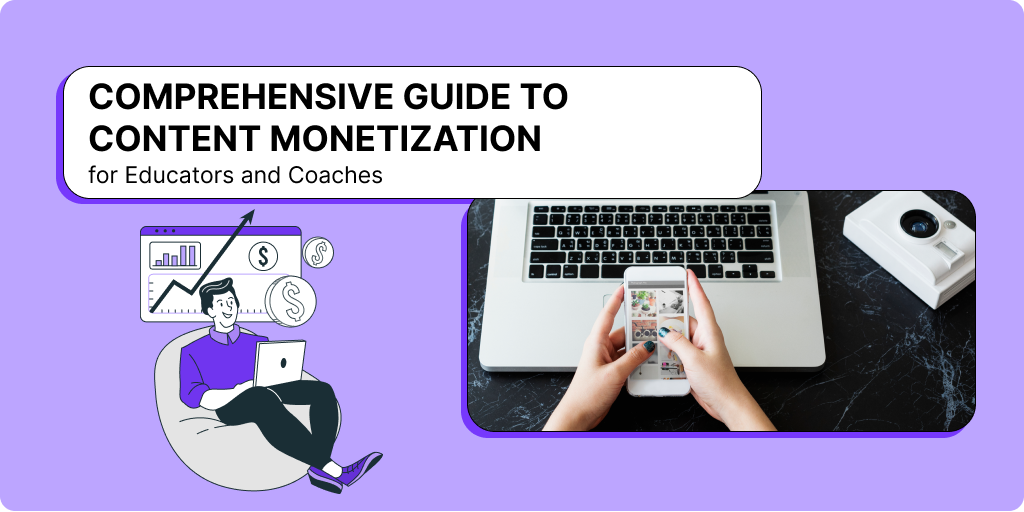In today’s technologically linked world, there are several methods to share your expertise with your audience – even from the comfort of your own home. Whether you make a website, host a podcast, or write a blog about your sector, you have various platforms and marketing tactics to pick from.
A webinar is one such possibility. Though often ignored, webinars are effective tools for participants to learn critical new skills or obtain industry insights from skilled presenters. Not only that, but they’re also a terrific method to build relationships with your audience and engage consumers with your company. Not sure where to begin? We’ll go over how to make a webinar in more detail below.
Benefits of hosting a webinar

- Reach and qualify more leads more frequently. Increase the number of qualified leads in your target market above other channels.
- Increase brand recognition. Promote your products and company in online events where you can simply interact with the audience.
- Present to more customers in less time. Spread your message to a large number of people.
- Increase reach with reusable content. Record your webinar and utilize it as a gated asset to get more leads.
How to create webinars: a step-by-step guide
If you’re ready for setting up a webinar, especially your first webinar, follow these steps to ensure that everything is in order.
Step 1. Choose a webinar topic
The first step in building a webinar is to choose an interesting topic. No matter how much you already know about your chosen subject, make sure your webinar is up to date with the most recent knowledge available in your field. A smart place to start is by looking at your competitors and other comparable webinars accessible online. Take notes on how they are constructed, the slides they use to show their arguments, and how you would modify things if you were creating your own.
Take notice of if comparable webinars charge for access. If your rivals are asking for money, consider providing yours for free or charging significantly less since this may provide you with an advantage in the long term. If you do decide to charge a price, make sure you give your audience something that your rivals aren’t.
Step 2. Choose a webinar platform
The very next step is to select the finest webinar platform. The format you select will assist you in determining the best one to utilize. Consider your demands and the objectives of your webinar before selecting a platform.
Consider the size of your audience, the amount of money you’re prepared to spend, and the equipment you’ll need for your presentation. Do you require a platform that can accommodate numerous speakers and a Q&A session? Make sure you select a provider that includes all of the features you require to give your presentation.
Step 3. Select a webinar format
Take caution with the information you’ll be presenting during the webinar. Begin with the format. What type of presentation will you be giving? What would you do, host? The difficulty of the issue and the number of speakers you want to have might help you limit your options. The four primary webinar format possibilities are as follows.
Discussion on a panel. This entails a moderator leading the conversation and asking questions of the panel participants. This is a terrific approach to display many viewpoints on the same subject or topic and is also a more conversational manner.
One speaker. Single-speaker presentations are suitable for smaller audiences since just one person is required to deliver the webinar and answer any questions from attendees.
Interviews. Interview webinars are particularly engaging because they promote a more conversational flow. Interviews entail an interviewer asking the person of interest pre-arranged questions. You may also invite your audience members to contribute to the discourse by enabling them to ask questions if time allows.
Live Q&A sessions. While Q&As are generally featured at the end of webinars, you may also build a webinar that focuses only on addressing questions from audience members. If you take this route, it’s strongly advised that you inform participants of the format ahead of time so they can prepare their questions.
Step 4. Develop and create a webinar content
Now that you have all of the necessary tools, it’s time to start developing webinar material. Here are some pointers to help you build your presentation.
Script. Create a script for the full webinar first so you can stay on track. It is not necessary to follow it word for word; in fact, you will most likely not. Nonetheless, putting everything down will assist you in organizing your presentation. Provide some leeway for diversions and on-topic tangents since your audience may welcome these extra insights.
Slides. You have various alternatives for making slides, including Microsoft PowerPoint, Keynote for Mac, and Google Slides. Whatever you pick, keep in mind that the first guideline of any slide presentation is to not include too much text on each slide. Your slides should serve as a guide and outline to assist the presenter in delivering the webinar. Visually appealing slides can assist in sparking your audience’s interest, so include any charts or graphs that might help convey information.
Step 5. Choose the best date and time for a webinar
Based on our expertise, some days and times perform better when attempting to draw the broadest audience possible. Choose a time for your webinar that is convenient for participants in different time zones.
The optimal times to host webinars vary depending on the subject. Personal finance and development webinars get the most people when they are conducted around 5 pm. This makes sense because the topic is more personal than professional, and the timing is immediately following the workday. But 10 am. and 11 am. are the most popular hours for registrations and attendance worldwide.
So when should you plan your webinar? Tuesday, Wednesday, and Thursday have the biggest amount of registrations and attendance, so choose one of those days.
Step 6. Promote a webinar

Before your webinar goes live, you’ll need to generate marketing assets to promote it. Here are some suggestions to help spread the news.
Newsletter. Email marketing efforts are useful for attracting audience members who will be interested in your webinar. If you already have a newsletter, this is an excellent way to promote your future presentation. You may even go the additional mile and give your members an incentive, such as an early access pass to interact with the presenter or discounted pricing. Additionally, don’t forget to send reminder emails to registered participants the day before your webinar.
Website banners. Your website is one of the finest venues to advertise your webinar. Make a banner or a popup lightbox to adorn the top of your website so that visitors are welcomed with information about your forthcoming event right away.
Special landing page. Many individuals prefer to develop a landing page to promote an event. This may act as a one-stop shop for logistical information regarding your webinar, from the time you’re broadcasting to the URL they need to log in.
Blog post. If you are an expert in your profession and do not have a blog covering your sector, it is time to start one. Starting a blog helps you to demonstrate your expertise and establish yourself as an authority in your area from which others may learn. It’s also wonderful for your website’s SEO potential. When you’ve established your blog, publish a post explaining the specifics of your webinar.
Social media. What better method to get the word out than via social media marketing? To advertise your webinar and attract new audiences, publish on social media sites like Facebook, Twitter, and Instagram. Consider employing hashtags or investing in sponsored articles to increase your reach.
Step 7. Do a webinar practice run
Make sure everything runs properly by conducting a test run utilizing the webinar software or tool ahead of time to get your speakers used to the webinar platform. A practice run can help you detect errors that are readily fixed but would otherwise be obvious when presenting in front of an audience.
Practice your script multiple times. This will help you to identify discrepancies, establish how much time to spend on each issue, and offer your knowledge to your audience more easily. Have a buddy or assistant view the full presentation online while you rehearse. They could notice mistakes that you missed.
This is also the time to put your equipment through its paces. Put your computer, software, and other equipment through its paces. To ensure that your computer can manage it all, try running all of the applications you’ll be using on it at the same time. Then, swiftly move between programs. Open an extra program to determine if there is any latency. If there are any problems, you may need to borrow a faster computer with additional RAM.
Step 8. Host a webinar
The next step is to select the finest webinar platform. The format you select will assist you in determining which one to utilize. Consider your demands as well as the objectives of your webinar when selecting a platform.
Consider the size of your audience, your budget, and the equipment you’ll need for your presentation. Do you require a platform that can accommodate numerous speakers as well as a Q&A session? Be sure the provider you select has all the features you require to give your presentation.
Step 9. Make a webinar recording
A recorded webinar is an excellent approach to continue generating leads even after you have stopped hosting. Posting the recording can increase your reach and generate further interest in the product, service, or information you provide.
After webinar promotion
Now that your webinar is over, you must determine what to do with the recording. You worked hard on your presentation, so make sure it’s available online for years to come.
You may upload it to YouTube and embed it on your website if you’re giving it away for free. If you want to keep charging people, try building a separate members section on your site and making the webinar available exclusively to paying members.
Furthermore, be sure you follow up with registrants, especially if the goal of your webinar is to generate sales. Input from your audience might be useful in determining how to improve for the next time.
Are webinars suitable for your knowledge business?
By providing useful expertise, you position your company as a reputable leader in your industry and create new prospects. When individuals register for your presentation, they provide you with their contact information, which you can use to advance them through your marketing funnel in the future.
Attendees are also more likely to be highly engaged since they are very interested in studying the subject at hand. These are the reasons why webinars are an essential component of a successful content marketing plan and a wonderful content marketing example.
While not every marketing endeavour is worth organizing a webinar for, consider the sorts of concepts that can draw a crowd and assist your organization. Webinars may take a long time to complete, so you want them to be engaging and intriguing enough to persuade people to enroll.
 Putting on a Show: Trible's Guide to Crafting Outstanding PowerPoint Presentations
Putting on a Show: Trible's Guide to Crafting Outstanding PowerPoint Presentations






